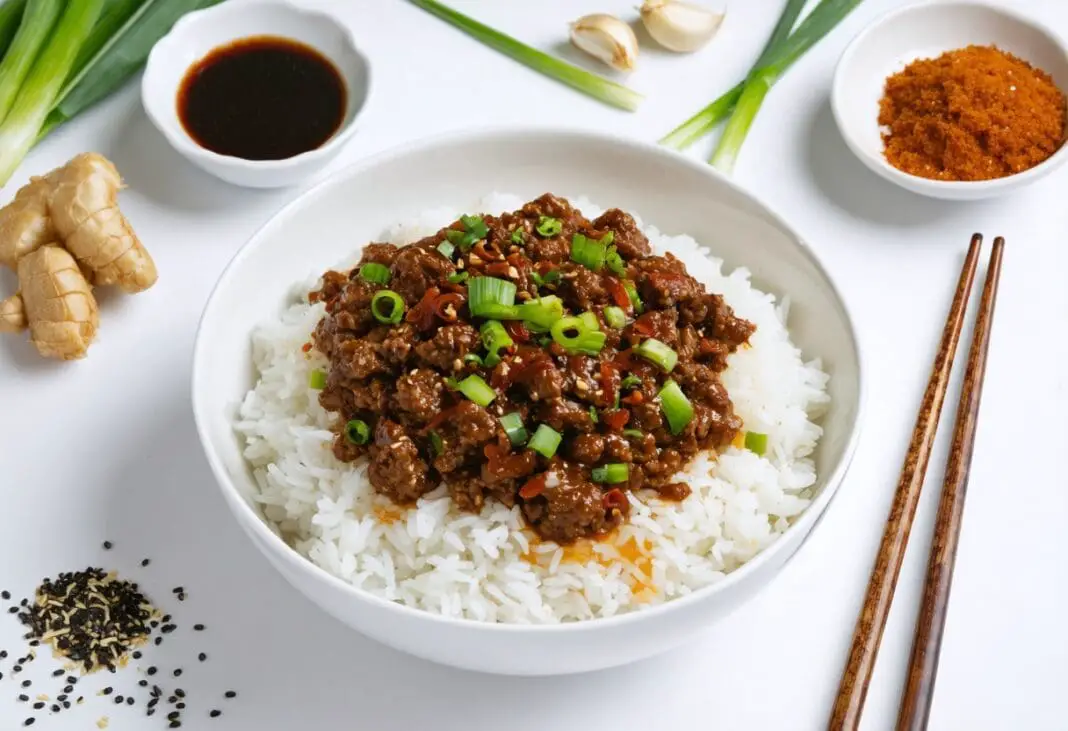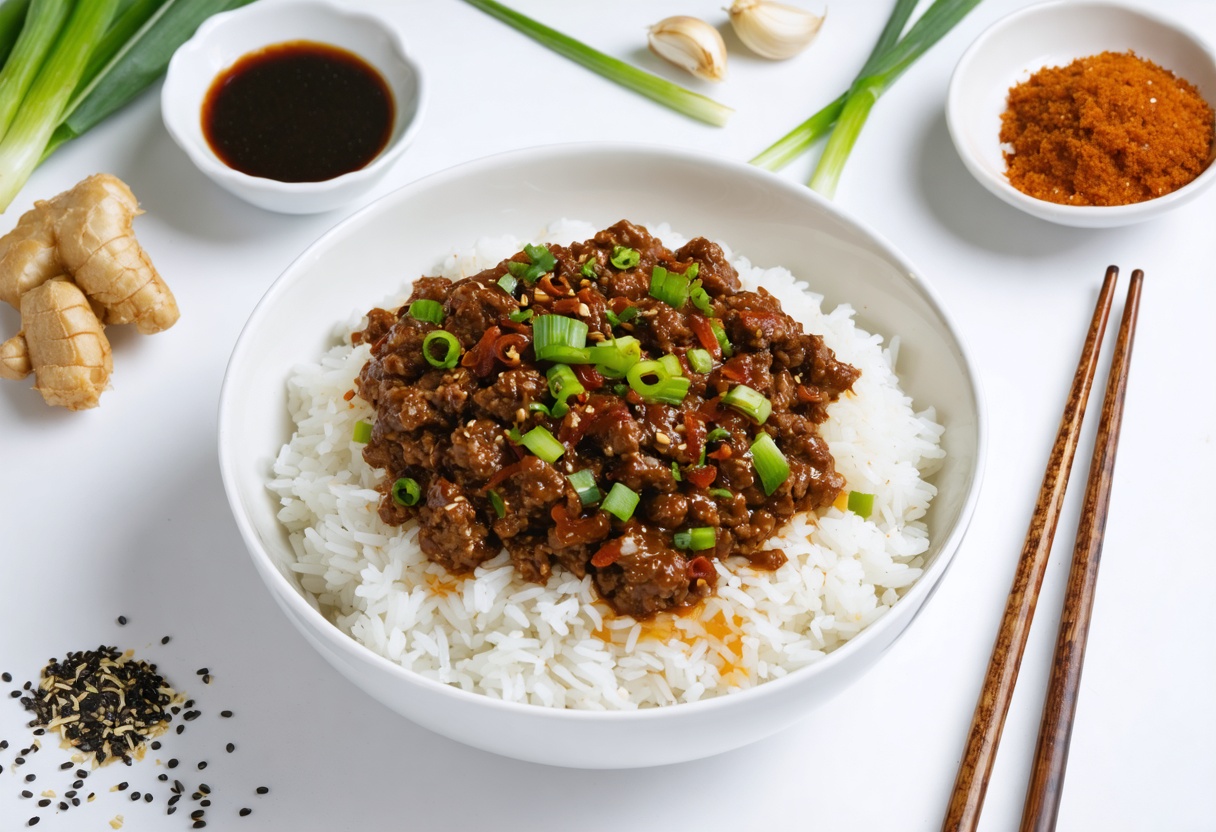That moment when it’s 5:30 PM and dinner needs to happen, but the pantry looks like it belongs to someone who forgot grocery shopping was a thing. Ground beef sits in the fridge, and suddenly Korean beef becomes the hero of busy weeknights everywhere. This sweet and spicy dish transforms basic ingredients into something that tastes like it took hours, not the 25 minutes it actually requires.
Ground beef works better than expensive cuts
Most people think Korean beef requires fancy ribeye or sirloin, but ground beef actually makes this dish shine. The smaller pieces absorb the sweet and spicy sauce faster than larger cuts ever could. Plus, ground beef costs a fraction of premium steaks while delivering the same satisfying taste that makes this recipe so popular.
Lean ground beef works best here, specifically the 93/7 ratio that most recipes recommend. The lower fat content means no greasy mess to drain, and the meat stays tender without becoming slick. Regular 80/20 ground beef creates too much grease and dilutes the sauce that makes this dish special.
Five pantry ingredients create restaurant taste
The magic happens with ingredients most people already have sitting around. Soy sauce, brown sugar, garlic, ginger, and red pepper flakes transform plain ground beef into something that tastes like it came from a Korean restaurant. No special trips to Asian markets or hunting down obscure ingredients that cost more than the entire meal.
Fish sauce makes the difference between good and amazing, though it’s technically optional. This one ingredient adds that deep, rich taste that makes people ask what the secret is. Red Boat brand sits in most Asian cooking enthusiasts’ fridges for exactly this reason – a teaspoon transforms any dish.
Sesame oil prevents sticking and adds authentic taste
Starting with sesame oil instead of regular cooking oil makes a huge difference in the final taste. The nutty, toasted aroma fills the kitchen and gives the beef that authentic Korean restaurant smell that makes everyone gather around the stove. Just a tablespoon and a half does the job without overwhelming the other ingredients.
Toasted sesame oil works even better than regular sesame oil if it’s available. The deeper, nuttier taste comes through in every bite, especially when combined with sesame seeds sprinkled on top at the end. This small detail makes the difference between homemade and restaurant-quality results that impress even picky eaters.
Fresh garlic and ginger beat bottled versions
Pre-minced garlic and ginger from jars work in a pinch, but fresh ingredients make this dish sing. Grating fresh ginger releases oils that jarred versions lose over time. The same goes for garlic – fresh cloves provide that sharp bite that mellows into sweetness when cooked with the beef and sauce.
Peeling ginger with a spoon edge works better than a knife and wastes less of the expensive root. Some cooks skip peeling altogether and just scrub the ginger well before grating. This shortcut saves time without sacrificing taste, especially when dinner needs to happen fast.
Brown sugar balances the salty soy sauce
Dark brown sugar provides the sweetness that makes Korean beef so addictive. The molasses in brown sugar adds complexity that white sugar can’t match. A quarter cup seems like a lot, but it balances the saltiness of the soy sauce and creates that glossy coating that clings to every piece of beef.
The sugar caramelizes slightly as it cooks, creating deeper taste and that shiny finish that makes the dish look professional. Some recipes call for honey instead, but brown sugar dissolves faster and provides more consistent results. The sweetness mellows during cooking, so the final dish tastes balanced rather than dessert-like.
Green onions add fresh crunch and color
Most of the green onions go into the pan during the last minute of cooking, wilting slightly but keeping their fresh bite. The remaining onions get scattered on top as garnish, providing both visual appeal and a fresh contrast to the rich, sweet beef. This two-step approach ensures some onions stay crisp while others blend into the dish.
Kitchen shears make quick work of chopping green onions directly over the pan. This eliminates a cutting board and saves time during those hectic dinner rushes. The white and light green parts can go in earlier since they take longer to soften, while the dark green tops work best as fresh garnish.
Rice timing matters more than beef cooking
Starting rice first prevents the common mistake of having finished beef sitting around while rice cooks. The beef takes maybe 10 minutes total, but rice needs 20-25 minutes depending on the type. Getting rice going first means everything finishes at the same time for a hot, cohesive meal.
Cauliflower rice works as a low-carb alternative and cooks much faster than regular rice. Frozen riced cauliflower needs just 5-7 minutes in a hot pan with some oil and salt. This option lets the beef be the star while still providing a satisfying base for the sauce.
High heat creates better browning and texture
Medium-high heat ensures the beef browns properly instead of steaming in its own juices. This browning creates deeper taste through the Maillard reaction, which gives the meat that rich, savory base that makes the sweet sauce pop. Low heat just creates gray, sad meat that tastes bland no matter how much sauce gets added.
Breaking up the meat with a wooden spoon or spatula helps it brown evenly, but avoid over-stirring in the first few minutes. Let the beef sit and develop that golden color before moving it around. Once the garlic and ginger go in, stirring becomes important to prevent burning these more delicate ingredients.
Sauce timing prevents burning and sticking
Adding the soy sauce mixture after the aromatics have cooked for a minute or two prevents the sugar from burning. Sugar burns faster than meat cooks, so timing this addition correctly makes the difference between glossy, caramelized beef and bitter, burnt disappointment. The sauce should bubble and thicken quickly over the hot beef.
The final minute or two of cooking allows the sauce to reduce and coat the beef properly. This step creates that glossy finish that makes Korean beef look so appealing. If the sauce seems too thin, cooking uncovered for an extra minute usually solves the problem.
Korean beef proves that weeknight dinners don’t have to be boring or complicated. With basic ingredients and simple techniques, this dish delivers restaurant-quality results in less time than ordering takeout. The sweet and spicy combination works for picky kids and adventurous adults alike, making it a reliable addition to any dinner rotation that needs more excitement.
Sweet And Spicy Korean Ground Beef
Course: Dinner4
servings15
minutes10
minutes320
kcalTransform ground beef into a restaurant-quality Korean dish with sweet and spicy sauce in just 25 minutes.
Ingredients
1 pound lean ground beef (93/7 ratio)
1 1/2 teaspoons toasted sesame oil
1 tablespoon finely minced garlic (4-5 cloves)
1 tablespoon fresh ginger, grated or minced
1/2 teaspoon red pepper flakes (adjust to taste)
1/4 cup low sodium soy sauce
1/4 cup dark brown sugar
1 teaspoon fish sauce (optional)
1 bunch green onions, chopped
Directions
- Start your rice first if serving with rice, as the beef cooks much faster than rice. Heat a large skillet over medium-high heat and add the toasted sesame oil. The oil should shimmer and smell nutty when it’s ready for the beef.
- Add the ground beef to the hot skillet and break it apart with a wooden spoon or spatula. Let it brown without stirring too much for the first 2-3 minutes to develop good color. Continue cooking and stirring occasionally until all the beef is well browned, about 5 minutes total.
- Add the minced garlic, grated ginger, and red pepper flakes to the browned beef. Stir everything together and cook for 1-2 minutes until fragrant. Don’t let the garlic burn or it will become bitter.
- Pour in the soy sauce, brown sugar, and fish sauce (if using). Stir well to combine all ingredients and let the mixture bubble and cook for 1-2 minutes until the sauce thickens slightly and coats the beef with a glossy finish.
- Turn off the heat and add about 3/4 of the chopped green onions to the pan. Stir them in so they wilt slightly from the residual heat. Reserve the remaining green onions for garnish on top of the finished dish.
- Serve immediately over steamed white rice, cauliflower rice, or your preferred grain. Top with the reserved fresh green onions and sesame seeds if desired. The dish is best served hot and fresh from the pan.
Notes
- Use 93/7 lean ground beef to avoid excess grease that dilutes the sauce
- Fresh garlic and ginger provide much better taste than jarred versions
- Fish sauce is optional but adds incredible depth – Red Boat brand is recommended
- Leftovers keep in the refrigerator for 5 days and reheat well in the microwave at 50% power
- This recipe doubles or triples easily for meal prep or larger families
Frequently asked questions
Q: Can I use regular ground beef instead of lean?
A: Yes, but you’ll need to drain the excess fat after browning, which can dilute the sauce. Lean 93/7 ground beef works best because it doesn’t create excess grease and allows the sauce to coat the meat properly.
Q: How spicy is this dish with the red pepper flakes?
A: With 1/2 teaspoon of red pepper flakes, this dish has a mild heat that most people can handle. Start with 1/4 teaspoon if you’re sensitive to spice, or increase to 3/4 teaspoon for more heat.
Q: What can I substitute for fish sauce?
A: While fish sauce adds amazing depth, you can skip it entirely or substitute with an extra teaspoon of soy sauce. The dish will still taste great, just without that extra umami punch that fish sauce provides.
Q: Can I make this ahead for meal prep?
A: Absolutely! This Korean beef keeps well in the refrigerator for up to 5 days and actually tastes better the next day. Reheat gently in the microwave at 50% power to prevent the meat from becoming tough.


